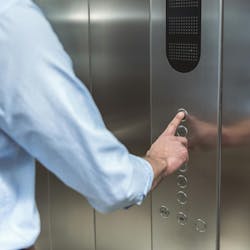This article originally appeared in the October 2024 issue of Security Business magazine. Don’t forget to mention Security Business magazine on LinkedIn and @SecBusinessMag on Twitter if you share it.
In recent years, many states have updated regulations to require video and two-way interactive solutions for elevator monitoring. These changes are largely driven by the Americans with Disabilities Act (ADA) and the International Building Code (IBC), which aim to improve safety and accessibility for all elevator users, particularly those with disabilities.
The ADA and IBC have introduced new requirements for elevator communication systems to ensure they are accessible to individuals with hearing, speech, or other impairments. The updated IBC 2021 code mandates that emergency phones in elevators provide both video and text communication. This is crucial for passengers who may be deaf or non-verbal, as it allows them to communicate their needs effectively during emergencies.
While not every state has adopted the code, check your state’s codes and consider adopting them to enhance the safety and accessibility of elevators, ensuring that all users can communicate effectively in emergencies. The core requirements of the updated code include:
- A two-way emergency communication system with audible and visual text modes.
- Interactive communication between passengers and monitoring staff.
- Operational systems whenever the elevator is in use.
- Video footage access for authorized emergency personnel.
Traditional voice-only communication systems have limitations, particularly for individuals who are unable to speak or hear. The new systems, by incorporating video and text capabilities, provide a more inclusive solution. For example, if a speech-impaired person is trapped in an elevator, they can use text communication to convey their situation, while the monitoring center can view live video footage to assess the situation.
This real-time visibility is crucial for emergency responders, allowing them to quickly determine the nature of the emergency and dispatch the appropriate assistance. Video monitoring also provides peace of mind for passengers, knowing that help is readily available and that they are being watched over by trained professionals.
The inclusion of text and video communication ensures that all passengers, regardless of their abilities, can communicate effectively in emergencies. This aligns with ADA requirements and promotes inclusivity.
Benefits of Advanced Elevator Monitoring Systems
Implementing a compliant elevator monitoring system offers several benefits:
Enhanced Safety: Video monitoring provides real-time visual verification of the situation inside the elevator car. This allows operators to assess the situation quickly and dispatch emergency services if needed.
Improved Accessibility: The inclusion of text and video communication ensures that all passengers, regardless of their abilities, can communicate effectively in emergencies. This aligns with ADA requirements and promotes inclusivity.
Regulatory Compliance: Adhering to the updated ADA and IBC codes helps property owners avoid fines and ensures that their buildings are up to code. This is essential for passing inspections and maintaining a good reputation.
Peace of Mind: Knowing that there is a reliable system in place provides reassurance to both building owners and elevator users. It reduces anxiety associated with elevator travel and enhances the overall user experience.
Incident Documentation: Video footage captured during emergencies can be securely stored and used for reviewing and investigating incidents. This documentation is valuable for improving security protocols and preventing future occurrences.
The new ADA and IBC requirements for elevator monitoring present an opportunity to enhance safety and accessibility for all users. By adopting advanced systems, building owners can ensure compliance with regulations, improve user experience, and provide peace of mind for everyone who uses their elevators.
When selecting an elevator monitoring system, it is crucial to choose one that meets the latest safety codes and provides comprehensive coverage. Choose one that offers advanced video and two-way communication capabilities, and systems designed to comply with ADA and IBC requirements, ensuring that all users have access to reliable emergency communication.
About the Author

Steve Mayer
Steve Mayer is Vice President of Operations and Administration for Emergency24, a wholesale central station monitoring provider. https://www.emergency24.us
